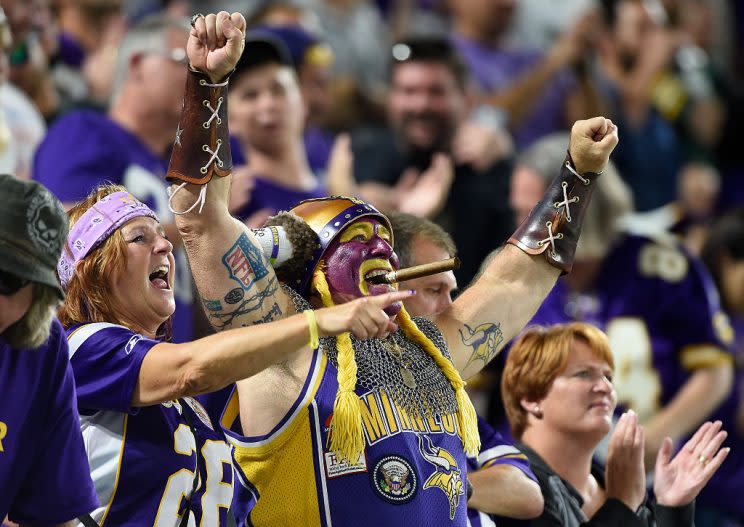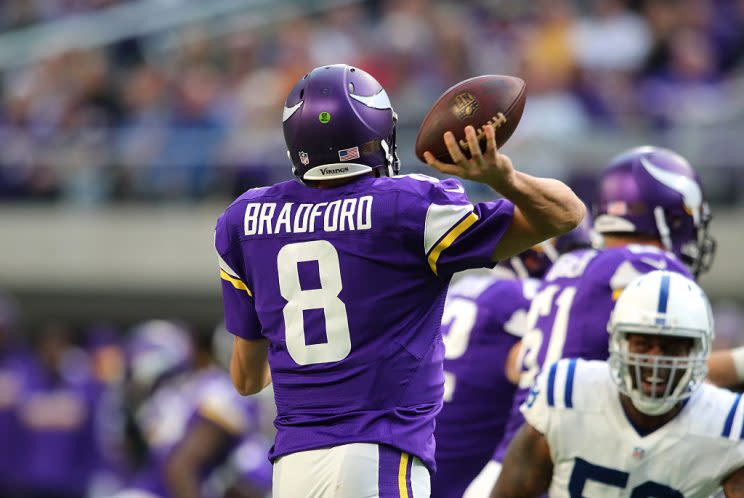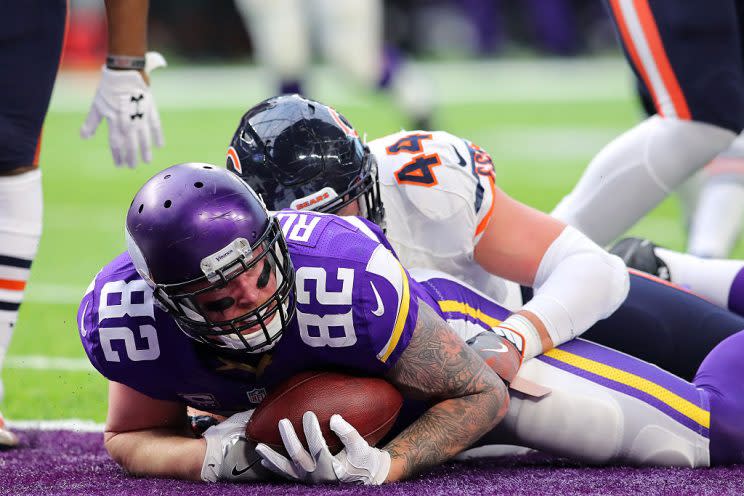Juggernaut Index, No. 26: Vikings roster loaded with fantasy backups

There have been exactly eight individual seasons in NFL history in which a quarterback has started eight or more games and completed over 70 percent of his passes. It’s an exceptionally rare feat, accomplished first by Sammy Baugh in 1945, then not again until Ken Anderson in the strike-shortened 1982 season. Entering 2016, every member of the 70 percent club was either a Hall of Famer or multi-year Pro Bowler.
And then Sam Bradford did what he did.
[Fantasy Football is open! Sign up now]
Bradford established a new NFL single-season record for completion percentage in 2016, in an otherwise forgettable season. Check his performance last year relative to every other QB who reached the 70 percent plateau:
Sam Bradford, 2016 – 71.6 comp%, 3.6 TD%, 7.0 Y/A, 7-8 record
Drew Brees, 2011 – 71.2 comp%, 7.0 TD%, 8.3 Y/A, 13-3 record
Drew Brees, 2009 – 70.6 comp%, 6.6 TD%, 8.5 Y/A, 13-2 record
Ken Anderson, 1982 – 70.6 comp%, 3.9 TD%, 8.1 Y/A, 7-2 record
Sammy Baugh, 1945 – 70.3 comp%, 6.0 TD%, 9.2 Y/A, 8-2 record
Steve Young, 1994 – 70.3 comp%, 7.6 TD%, 8.6 Y/A, 13-3 record
Joe Montana, 1989 – 70.2 comp%, 6.7 TD%, 9.1 Y/A, 11-2 record
Alex Smith, 2012 – 70.2 comp%, 6.0 TD%, 8.0 Y/A, 6-2-1 record
Bradford is the only quarterback on that list who, in his historically accurate season, averaged less than 8.0 yards per attempt. He’s also the only guy whose team lost more than it won. He threw just 20 TD passes over 15 games. Basically, he remained a risk-nothing, do-nothing passer, despite the record-breaking performance. He attempted just 3.6 deep passes per game in 2016 according to Player Profiler, and he averaged only 3.6 air yards per throw. (For comparison’s sake, Kirk Cousins averaged 5.9 deep balls per game and 5.2 air yards per attempt. Andy Dalton averaged 4.2 and 4.3.)
When Minnesota head coach Mike Zimmer said his quarterback had “done an unbelievable job”, he probably did not mean that Bradford had been unbelievably Bradford-like, but that’s as far as anyone should go.

(Photo by Adam Bettcher/Getty Images)
Of course we should acknowledge the unusual circumstances that brought Bradford to the Vikings in the first place, which could not have been easy for the player or team to navigate. He was dealt to Minnesota last September, following Teddy Bridgewater’s devastating knee injury. Just two weeks after the trade, Bradford found himself starting against the Packers and guiding his team to a 17-14 win. Transitions like that certainly aren’t easy in the NFL. The Vikings gave up quite a bit in terms of future draft assets for Bradford, but he performed capably, if not unbelievably. He finished as the No. 23 fantasy scorer at his position last season, and that’s the neighborhood where you should expect him to land in 2017.
But we kinda/sorta like the Vikings receiving corps, no?
Sure, we like ’em well enough. It’s a group without an elite playmaker, but that’s probably OK, because a player like Julio or OBJ or Megatron would be wasted on Bradford. Minnesota has a clearly defined hierarchy at receiver, with Stefon Diggs and Adam Thielen atop the depth chart.
Diggs opened 2016 with a pair of 100-yard performances, but early-season injuries derailed his year. He finished with a team-leading 84 catches for 903 yards on 111 targets, though only 10 of his catches went for 20-plus yards. Diggs was held to less than 60 yards in eight of his 13 games and he found the end-zone just three times. He’s suggested more than once during the offseason that inadequate fitness played a role in his slowdown, an unnecessary and uncommon act of personal accountability; he seems determined not to miss games in 2017. So that’s cool. For a guy with 100-catch, 1100-yard upside, Diggs is well priced in Yahoo drafts (ADP 98.8).
Thielen broke out in a big way in his third NFL season, catching 69 passes for 967 yards and five spikes on just 92 targets. If you started him in a fantasy title matchup in Week 16, then you are no doubt a ride-or-die Thielen loyalist. That week, when you needed him most, he caught a dozen passes for 202 yards and two scores at Green Bay, shaming and face-planting the Packers secondary on this long TD. (Please note Thielen’s post-TD crowd taunting in that clip. He has a saucy side.)
Despite the fact that Thielen was a fun fantasy story, we shouldn’t forget that he delivered 516 of his 967 yards in just four games. In the other 12 weeks, he had only two 60-yard performances. His 202-yard outburst was sandwiched by weeks in which he totaled one reception for seven yards. Such is life in a low-yield passing game. Thielen got paid in the offseason ($11M guaranteed), and he’s locked in as a starter for the Vikes.

The most bankable player in this team’s receiving corps is, without question, tight end Kyle Rudolph. He led his position last season in total targets (132), and, more importantly, he saw the most chances in the red-zone (25) and inside the 10-yard line (12). Not surprisingly, Rudolph caught seven of Bradford’s 10 touchdown passes. There’s no obvious reason to expect his role to change in 2017. Last year, he saw at least eight targets in each of Minnesota’s final six games. He’s an ideal short-range, sure-handed receiving option for Bradford.
Rudolph is available at a dirt-cheap price, considering his situation (ADP 109.6, TE11. The man finished as the No. 3 tight end in fantasy last year, and drafters are basically behaving as if it never happened.
Behind the top three receiving options for the Vikings, it’s a wasteland. Former first-rounder Laquon Treadwell is coming off a disastrous one-catch rookie season, yet he’s reportedly running ahead of the other depth chart options. Treadwell was a terrific collegiate receiver who bombed his pro day and the combine (4.63 speed, 33-inch vert). Athletically, he was not a first-round talent; the Ole Miss tape was full of moments in which he overpowered DBs without separating.
Still, even the scouts who nailed Treadwell’s pre-draft profile had to be surprised at how little he saw the field as a rookie. He’s a long way from fantasy relevance, though an injury to Diggs or Thielen would force him into a meaningful role. Jarius Wright is an uninteresting player, battling for a role. Free agent flier Michael Floyd has had the sort of offseason that gets covered by TMZ, which is rarely good. He is not to be drafted.
How high is too high to draft Dalvin Cook?
Naturally, one year after Minnesota used its top draft pick on a player with poor measurables and watched him bust, the team used its top pick on another guy with poor measurables. What could go wrong?
Cook, as everyone knows, was a ridiculously productive runner at Florida State. He gained a whopping 5399 scrimmage yards over three seasons, including 2253 as a junior, and found the end-zone 48 times. Cook averaged 6.5 yards per carry and 11.8 per catch in his FSU career, and he topped 100 rushing yards in nine of his final 10 games. He was great. Cook’s collegiate O-line was no less great, routinely allowing him to race unimpeded through wide rushing lanes.

Carrying the ball in Minnesota won’t be so easy. The Vikings O-line graded out as one of the league’s worst last year, particularly against the run. That weakness remains a major worry. The team signed two new tackles in the offseason, Riley Reiff and Mike Remmers, while also drafting a center who seems likely to start (Ohio State’s Pat Elflein). Things should get somewhat better for this unit, because … well, because they can’t get worse. But there are no stars here. It’s an issue.
Cook had a brutal combine in the areas that matter most, despite the brilliant collegiate resume. His three-cone and 20-yard shuttle times were among the worst at his position (7.27, 4.53) and his jumps weren’t much better. He was a seventh percentile SPARQ athlete, which does not inspire confidence — in fact, his miserable combine probably bounced him from the first round.
Someone in every league is certain to like Cook more than I do, so I’m pretty much guaranteed to have zero shares, for better or worse. He’s the presumptive lead back for this team, however. Latavius Murray signed a three-year, $15 million deal back in March, but he’s missed the team’s offseason program following ankle surgery. The hope is that he’ll return for some significant portion of training camp, but, at present, his ETA is a mystery. Jerrick McKinnon is still in the picture, but he’s presumably third on the depth chart, hoping for a passing-down role. Draft him only in deep PPR formats.
Minnesota’s defense could be a big purple terror.
Mike Zimmer’s D was the league’s third best in terms of yards allowed last season (314.9 YPG) and sixth in scoring (19.2 PPG). This group also ranked fifth in sacks (41) and tied for seventh in takeaways (27). Minnesota has no shortage of IDPs to target, including DEs Danielle Hunter and Everson Griffen, who combined for 20.5 sacks last season. There’s talent at every level of this defense; the Yahoo fantasy crew ranks this unit solidly as a top-10 fantasy D/ST. The Vikings were memorably roasted by Aaron Rodgers late last year (347 yards, 4 TDs), but he was the only opposing QB to top 275 passing yards against them.
Assuming Bradford is up to his usual Bradfording, Minnesota’s defense will need to be even stingier than it was last season if this team is going to challenge for division supremacy in 2017.
2016 Offensive Stats & Ranks
Points per game – 20.4 (23)
Pass YPG – 257.4 (17)
Rush YPG – 75.3 (32)
Yards per play – 5.0 (28)
Plays per game – 62.9 (23)
—
Previous Juggernaut Index entries: 32) NY Jets, 31) San Francisco, 30) Cleveland, 29) LA Rams, 28) Baltimore, 27) Chicago, 26) Minnesota



